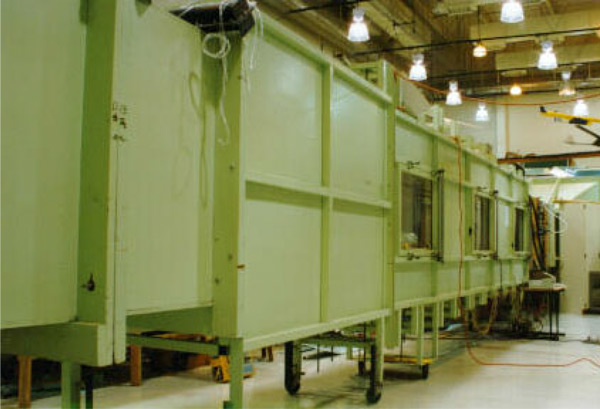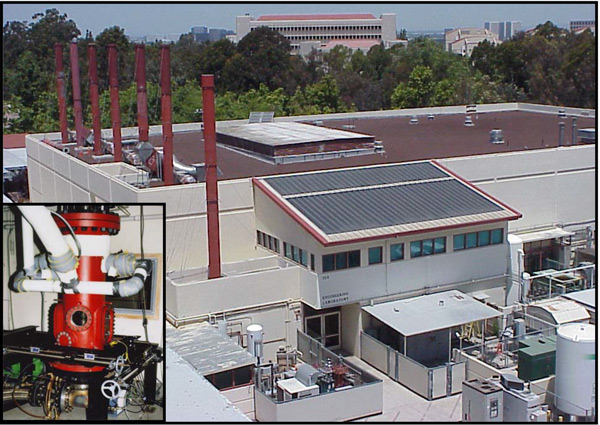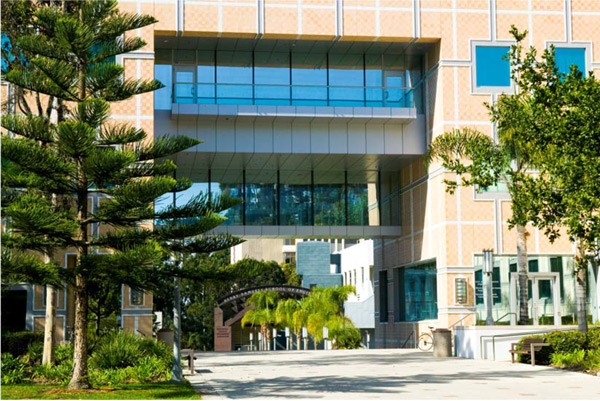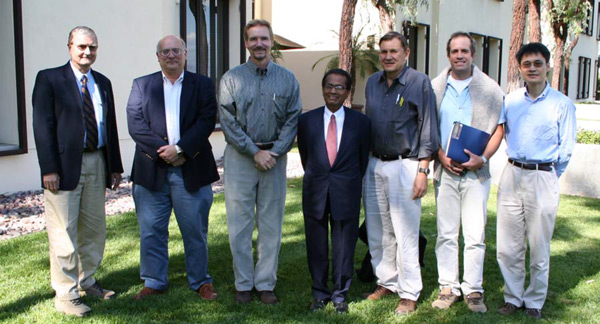Department of Mechanical and Aerospace Engineering
History of Aerospace Engineering at UCI
History of Aerospace Engineering at UCI
William A. Sirignano and G. Scott Samuelsen
Department of Mechanical and Aerospace Engineering
University of California, Irvine
Irvine, CA 92697-3975
The University of California, Irvine (UCI) Campus was established during the early 1960s and first admitted students in 1965. The School of Engineering was amongst the first schools that were created at the start of the Campus. However, at that time, there was not a program in mechanical engineering or aerospace engineering. Dr. G. Scott Samuelsen, a degreed mechanical engineer, was hired as an assistant professor in 1970 in the Environmental Engineering Program. Later, he would be instrumental in the developments of both the mechanical engineering and aerospace engineering programs.
In its first two decades, the School of Engineering operated without departments but did by 1980 have four distinct curricula, including the Mechanical Engineering Curriculum chaired by Professor Samuelsen. The School formed three departments in 1983, including the Department of Mechanical Engineering with Professor Donald Edwards, a distinguished AIAA-prize winner, as Department Chair. Later, with the School of Engineering led by Dean William A. Sirignano, another AIAA prize winner, the Department voted to change its name to Department of Mechanical and Aerospace Engineering in 1990. At the same time, a Specialization in Aerospace Engineering was added as an option to the B.S. in Mechanical Engineering degree program. Discussion began on a new undergraduate degree in Aerospace Engineering; it was implemented and first entered the UCI catalogue in 1993. Beginning then, the Department managed two undergraduate B. S. degree programs. The M.S. and Ph.D. graduate degrees were changed in 1994 to degrees in Mechanical and Aerospace Engineering. Since that time, the Aerospace Engineering program has continued to grow in size, impact, and stature. In this article, some details about this history over the past few decades will be provided.
Development of Faculty and Facilities
Substantial elements of aerospace engineering existed in the UCI Department of Mechanical Engineering prior to its formal name change and the introduction of the Aerospace Engineering degree. Professor Paul Arthur, an extremely capable and popular aerospace engineering and fluid dynamics instructor joined the faculty in 1968 as a systems engineer. In 1970, Professor Scott Samuelsen joined the UCI faculty and created the UCI Combustion Laboratory which emphasized gas-turbine-propulsion applications of combustion. As shown by Figure 1, this laboratory was one of the early combustion labs to deploy lasers for non-intrusive quantitative diagnostics of reacting flows. Professors Arthur and Samuelsen would later be founding faculty members for the Mechanical Engineering Curriculum.
In the 1970s, several important additions to the faculty were made that impacted our strength in aerospace-related areas. Professor Said Elghobashi joined the faculty in 1978, bringing a new capability in computational fluid dynamics, which was just emerging as a research area and powerful engineering tool at that time. Professor John LaRue, a turbulent-flow expert joined the faculty in 1979. To support his research, a state-of-the-art subsonic closed-return wind tunnel, shown in Figure 2, was designed and installed in June 1981. For many years, it was located off-Campus in leased space because the growing Campus had a temporary shortage of laboratory space. It was based on a design used at the Boeing Scientific Research Laboratory but was re-designed to include deflecting walls to bring the downstream pressure gradient to zero, a new contraction section to improve the test-section profile uniformity, and a modified test section. The tunnel has a test section of 2 by 3 feet, a length of 24 feet, and a top speed of 40m/sec. In 1989, the department purchased an open-return wind tunnel with a test section that is 12 by 12 in cross-section and is equipped with a force balance and other aerodynamic instrumentation. It has very uniform and stable test-section flow and has been a vital component in our instructional laboratory.

Figure 1. Early experiment in the UCI Combustion Laboratory. Laser diagnostics are employed.
The aerospace-engineering capability continued to grow during the early 1980s. In 1982, Professor Don Edwards, a renowned heat-transfer expert, moved from UCLA to UCI bringing a needed level of experience to provide mature leadership and a mentoring ability. Professor Carl Friehe joined the faculty during the same year, bringing an additional capability in experimental fluid dynamics. The growth was supported by the Dean of the School of Engineering during the late 1970s and early 1980s, Dr. Allen R. Stubberud, Professor of Electrical Engineering and a world renowned expert in signal processing. He resigned the deanship in 1984 and took a two-year leave from UCI to serve as Chief Scientist of the Air Force; he was also is a Fellow of the AIAA.

Figure 2. Closed- loop subsonic wind tunnel.
When the new 23,000-square-foot Engineering Laboratory Facility was completed in 1987, Professors LaRue and Samuelsen moved the wind-tunnel and combustion facilities into that building. Later, more experimental facilities for new faculty were added in our 75,000-square- foot Engineering Gateway Building. Compressors to deliver high-pressure air at large flow rates and high-bay space are special features of this facility.

Figure 3. The Engineering Laboratory Facility (ELF) built in 1985-87 has a large capacity (ca. 4 lbs/sec) for compressed air and state-of-the-art test cells. The high-pressure facility (insert), for example, simulates a spectrum of propulsion conditions (up to 10 atm, and non-vitiated 1800°F flow) with optical access and a three-dimensional traverse.
The growth continued during the middle 1980s to early 1990s. Dr. William Sirignano came to UCI in early 1985 and served as Dean of the School of Engineering for about a decade. He brought theoretical expertise in combustion, fluid dynamics, and jet propulsion as a faculty member and a determination as Dean to create a very strong formal Aerospace Engineering component to the School. The name change, the new undergraduate degree, modified graduate degrees, and increased laboratory space occurred during his deanship. More importantly, the 8- person regular-ranks faculty of the 1985 Department of Mechanical Engineering grew into the 20-person regular-ranks faculty of the Department of Mechanical and Aerospace Engineering (MAE) by the early 1990s. In fact, the growth was even greater than the twelve that these numbers indicate since several materials faculty moved from MAE to another department by the early 1990s. During his deanship, Professors Don Edwards, Scott Samuelsen, and William Schmitendorf served as able and effective Department Chairs committed to the strengthening of the department, including the aerospace-engineering component. The new aerospace-engineering faculty hires included Professors Feng Liu (computational aerodynamics and turbomachinery), Ken Mease (guidance, navigation, and control, or GNC) Melissa Orme (experimental fluid dynamics and orbital mechanics), Dimitri Papamoschou (experimental compressible and turbulent flows), and William Schmitendorf (control theory). Other faculty who were primarily mechanical engineers did strengthen our capabilities in dynamics and controls and in fluid and thermal sciences. During this same period Professors Edwards and Arthur decided to retire. Professor Edwards maintained a relation with MAE as an instructor for some years. The growth in MAE was accommodated by moving the departmental headquarters and most of its faculty offices and laboratories to the new Engineering Gateway Building in 1994. Several facilities in fluid dynamics, combustion, computational methods, and GNC are housed in this building.

Figure 4. The Engineering Gateway Building: home of MAE at UCI. The School of Engineering McDonnell-Douglas Auditorium is in the background.
The MAE Department has made three very significant additions to its aerospace engineering faculty in the past decade under the leadership of three consecutive Department Chairs, Professors Said Elghobashi (1997-2002), Dimitri Papamoschou (2002-2005), and Roger Rangel (2005-present), and Dean Nicolaos Alexopoulos (1997-present). Professor Haris Catrakis was hired as an assistant professor in 1998 and just recently tenured. He added to our research strength in experimental turbulent flows and to our teaching strength in fluid dynamics and jet propulsion. In 1998, Dr. Robert H. Liebeck joined our faculty as a part-time adjunct professor. He is a premier aircraft designer who has worked for decades at the Long Beach facility originally operated by Douglas Aircraft, later by McDonnell-Douglas, and now by Boeing. Recently, he is known for his pioneering blended-wing design. Professor Liebeck teaches several critical senior-year required aerospace-engineering courses at UCI in spite of his full-time leadership position at Boeing. We are very fortunate to have his practical experience strengthening our teaching program.
Until 2002, our aircraft structures courses were not taught by regular-ranks MAE faculty. In that year, Professor Satya Atluri moved to UCI from UCLA, providing instantaneous worldwide visibility in aircraft/ spacecraft structures and the underlying science of solid mechanics. Under his leadership, we are now recruiting other strong faculty in this structures area. Professor Daniel D. Joseph recently entered phased-retirement at the University of Minnesota and joined us on a part-time basis as a Distinguished Adjunct Professor. He strengthened our research program in fluid dynamics.
Over several decades, an outstanding aerospace-engineering faculty has been developed. It includes four members of the National Academy of Engineering, four Fellows (including one emeritus faculty member) and three Associate Fellows of the AIAA, as well as Fellows of the ASME, American Physical Society, IEEE, and other societies. Many AIAA prizes have been won by our faculty: Thermophysics and Heat Transfer Award, Pendray Aerospace Literature Award (twice), Propellants and Combustion Award, Energy Systems Award, Aircraft Design Award, Spirit of St. Louis Prize, and Structures, Structural Dynamics, and Materials Award. The FAA Excellence in Aviation Award has also been won. In addition, prizes and Fellow status from several other organizations, not specifically dedicated to space or atmospheric flight, have been awarded to our faculty. Figure 5 shows the current aerospace engineering faculty.

Figure 5. Faculty members from left to right are Professors G .S. Samuelsen, W. A. Sirignano, K. D. Mease, S. N. Atluri, J. C. LaRue, H. J. Catrakis, and F. Liu. Professors S. E. Elghobashi, C. A. Friehe, R. H. Liebeck, M. E. Orme, and D. Papamoschou are missing.
Curricula and Students
During the late 1970s and early 1980s with Professor Samuelsen as the Mechanical Engineering Curricula Chair, several aerospace-related courses were created. These included an orbital-mechanics course, a compressible-flow course, and an aeronautical-design course.
An engine course was also developed that covered aircraft engines and internal combustion engines was developed. Later, Professor Sirignano re-organized that course to cover jet engines for air flight and for space flight. In 1987, the Department of Mechanical Engineering began its plan to formalize the aerospace-engineering curriculum. The "Aerospace Specialization" added as an option (through proper selection of electives) in the B.S. in Mechanical Engineering degree program during 1990. At UCI, specializations are formally identified on student transcripts. As noted above, the Department, in the immediately following years, changed its name, created the second undergraduate degree program in Aerospace Engineering, and placed “Aerospace” into the titles of its M.S. and Ph.D. degrees. Both undergraduate degree programs, AE and ME, are ABET accredited.
The undergraduate program in both ME and AE has included a major design component. In fact before Aerospace Engineering had any formal status at UCI, the ME design course included some interesting aerospace-engineering design projects. One noteworthy project during the 1980s involved a human-powered flight vehicle shown in Figure 6.

Figure 6. UCI undergraduate students testing and evaluating the human-powered flight vehicle.
The Aerospace Engineering curriculum is one of the most demanding at UCI with 193 quarter units required, including 45 units for breadth courses outside of math, science, and engineering. Twelve courses in math, physics, and chemistry; twenty-two engineering courses; plus a technical elective are required. The program presents the fundamentals of both aeronautics and astronautics with more emphasis on the former. Current undergraduate Aerospace Engineering majors at UCI number 165 with freshman through senior class sizes varying between 36 and 48 students. Applicants for Fall 2005 numbered 450 for Freshman year and 63 for Advanced Standing.
A student section of the AIAA has existed at UCI since 1973, established by Professor Robert Lee, a controls expert, who served at UCI from 1967 to 1977. In 1988, UCI hosted the West Coast AIAA Student Conference. Professor Carl Friehe was awarded the AIAA Region 6 1987-1988 Faculty Advisor Award. The UCI Chapter of the Sigma Gamma Tau Aerospace Engineering Honor Society was installed, with approval of the National President of Sigma Gamma Tau, on June 3rd, 2005. On the same day, the first initiations of Sigma Gamma Tau undergraduate honor students at UCI were also conducted.
The graduate curricula was strengthened in the late 1980s and 1990s with the addition of courses in nonequilibrium gasdynamics, applied mathematics, computational methods for compressible flows, multiphase flows, turbulent shear flows, experimental fluid dynamics, and advanced controls. More recently, solid-mechanics courses have been added to the graduate curriculum.
Industrial Interactions
We are fortunate to have UCI located in Orange County in Southern California where the aerospace industry is extremely strong. Many of our graduates are hired into that industry which has maintained strong relations with our MAE Department and with our School of Engineering. Many gifts have come from this industry. For example, substantial gifts have led to the construction of the McDonnell-Douglas Auditorium (shown in the background of Figure 4) and the Rockwell Engineering Center, both designed by the renowned architect, Frank Gehry. Our alumni commonly have remained in Southern California, serving as engineers and managers at organizations such as Aerospace Corporation, Boeing, General Dynamics, JPL, McDonnell-Douglas, Northrop-Grumman, Parker Aerospace, Raytheon, Rockwell, United Technologies, and Universal Space Lines. Examples of alumni in leadership positions include Dr. Roger Brum, President Meggitt Defense Systems; Dr. Jeffrey L. Emdee, Director of the Propulsion Department, Engineering and Technology Group, Aerospace Corporation; Dr. Robert E. Peck, Chair, Department of Mechanical and Aerospace Engineering, Arizona State University; and Dr. Scott W. Shaffar, Director, Knowledge Management, Northrop Grumman Integrated Systems. Many of our students have also been placed in the Midwest and East, e.g., Pratt & Whitney in Connecticut. Our gas-turbine and rocket research hasincluded collaborative work with industry and support directly from industry with notable examples of General Electric, Parker Hannifin, Northrop-Grumman, Pratt & Whitney, Rolls-Royce, and SEP in Europe. Over the past decade, a popular Gas Turbine Combustion Short Course has been offered annually, initiated with the late Professor Arthur Lefebrve, and has attracted to date over 250 employees of aerospace companies and regulatory agencies.
The Future
UCI intends to grow and strengthen its aerospace engineering programs in undergraduate education, graduate education, and research. At present, it is searching for four new faculty members in the specialties of aircraft/ spacecraft structures, advanced space propulsion, and GNC. Another Engineering building that will benefit the MAE Department as well as other Engineering departments is in the final stages of design. UCI has formally designated Aerospace Engineering as a Program of Excellence and is committed to its strengthening through growth. The intention is for this very young and rapidly growing aerospace- engineering program, which has achieved top-thirty USNEWS graduate-program ranking a little more than a decade after its formalization, to continue to improve substantially its standing.
